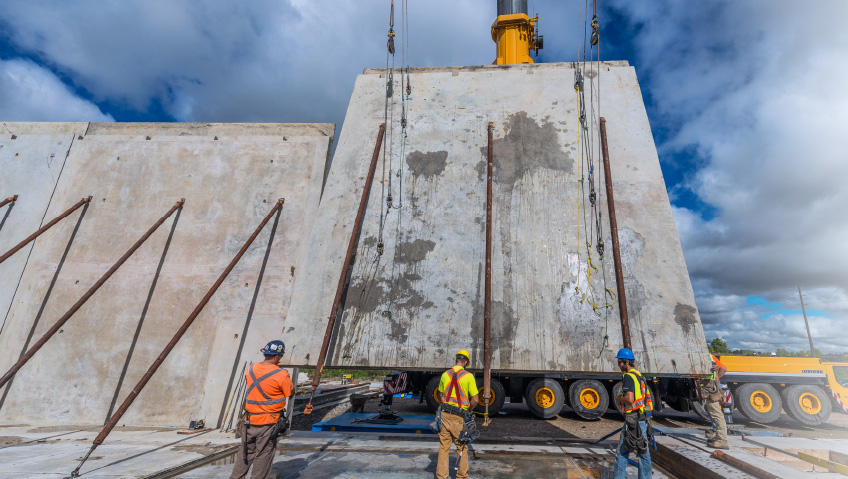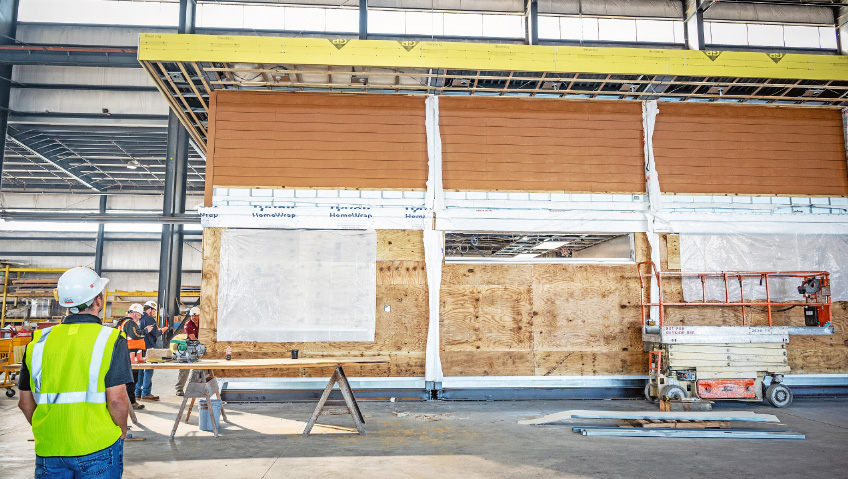The National Institute of Building Sciences (NIBS) is a non-profit, non-governmental agency established by Congress in 1974. With headquarters in Washington, DC, NIBS is tasked with developing innovative solutions for the built environment that serve the public interest by advancing building science and technology.
To learn more about NIBS and its recent initiatives (that if adopted by industry stakeholders could be game changers), we spoke with Roark Redwood, NIBS’ Senior Vice President of Technical and Government Solutions, and Johnny Fortune, Executive Director, U.S. National BIM Program.
Fortune, who has been in his current position for a year, brings to it a wealth of experience. He worked in the industry for 20 years, where he saw that alarming levels of inefficiency were rife. Now, he couples that observation with a passionate belief in the potential of the building information modeling (BIM) program that NIBS supports to positively improve the industry’s efficiency levels.
“The problem that exists in the construction industry is that it lags behind almost every other industry in terms of productivity,” Fortune says. “The industry surrounding the built environment has been very slow to adopt technology that could make it more productive. I had focused on productivity issues for many years within the construction firms for which I worked, trying to make them more efficient. When I learned of NIBS and the work being done by this organization in information management and the development of standards of data sharing, I saw it as an opportunity to impact inefficiencies and productivity on a national scale,” he says.
“After 10 years of volunteering with NIBS and doing some contract work around re-writing the building information modeling manual for the Department of Veterans Affairs, I knew this was where I wanted to invest my time and energy,” he continues. “Rather than just working for one company, I wanted to help the entire industry by providing it with the data sharing capability so desperately needed.”
The first version of the National BIM Standard – United States, a document produced by the BIM Program, was introduced in 2007 to “provide consensus-based standards through referencing existing standards, documenting information exchanges, and delivering best practices for the entire built environment.”
With BIM standards freely available to all stakeholders, Fortune, along with the committee members who worked on updating them, believes that “detailed models can deliver accurate products that can be used during commissioning and operation to ensure functionality throughout the life-cycle of facilities while delivering high-performance, carbon-neutral, and net zero energy buildings.”
Since 2007, the standards have been revised and updated three times, with input from numerous stakeholders who volunteer on a steering committee and on working groups. Now Version 4 is set to be softly launched at the NIBS Building Innovation Conference, September 5-7 in Washington. This annual event draws stakeholders from across the country who have an impact on the built environment and are seeking solutions for inherent industry problems. Following the formal release, the standards will be freely available to all interested parties.
Fortune noted some significant changes for Version 4, which include “cleaning up the language to clarify the standards” and introducing new features which will impact the standards’ overall usefulness and increase acceptance among stakeholders.
One such feature is an entirely new section on project owner requirements, which will enable owners to be more precise in what they require for their projects and help them define their BIM requirements. They can then clearly specify what they want to see, what the outcomes will be, and communicate them to their project stakeholders: the architects, engineers, designers, and contractors.
What this means in practical terms, Fortune says, “is that since the owners are the ones funding the project, they can put the requirements for data standards into their plan, and then the rest of the stakeholders are subject to compliance and need to follow suit.”
The standards are related to all the issues surrounding the construction industry—safety, workforce, environment. He shared an example of how the standards could assist with reducing carbon emissions by approaching the topic through the type of building materials and furniture that will be used in the building.
“Where the program could assist with decarbonization is by defining new standards related to the rating of materials in terms of their embodied carbon, and putting it in a database that could report a cumulative rating for all of the materials and objects in a building,” Fortune explains.
The standards are also of critical importance in that they can capture the data at different stages of a project or a building’s life cycle and ensure that data can be passed from one stakeholder to another.
There is a plethora of technology, tools, and applications available on the market to help individual stakeholders complete their job. But all too often the information is locked up in a software application and doesn’t get transferred to the next stakeholder when the project is handed over, resulting in inefficiency as the same information will have to be modeled repeatedly, with the owner having the greatest information deficit.
“This doesn’t mean that everyone has to purchase the same software applications,” Fortune said, “but all stakeholders have to be able to get the original data without having to input the same information over and over again, and this is why we are promoting open data standards.”
The previous three versions of the National BIM Standard – United States had a life cycle of three to five years, but Version 4 has adopted an agile, modular approach. This will enable updating of modules within the standard independently, thereby eliminating long revision cycles and allowing for more frequent updates and the ability to add new modules.
Mitigation and building resilience initiatives
NIBS’ Redwood is responsible for the overall performance of the Technical and Government Solutions department by ensuring innovative execution and delivery of services, completing programs, and expanding new business development opportunities. This includes BIM.
Redwood is an architect with 23 years of experience, delivering federal, cultural, leisure and entertainment, higher education, mixed-use, aviation, industrial, commercial, and residential projects. He is an experienced leader of diverse teams of professionals for a variety of clients and project types, complexities, budgets, and delivery methods.
In addition to BIM, there are several mitigation and resilience projects underway through NIBS’ Technical and Government Solutions department.
These include TurboGrants, which is the brainchild of the NIBS Vice President of Engineering, Jiqiu Yuan. TurboGrants is directed toward mitigation and resilience so that non-profit organizations looking to secure or help their communities recover from natural disasters will be able to find resources provided by FEMA, understand the eligibility requirements, and apply.
“This is about being proactive and ensuring accessibility,” Redwood said of TurboGrants. “The notion among Americans is that recovery funds are a given, but the journey to tap into them is not. That’s where TurboGrants steps in.”
Other projects include the development of a mitigation investment roadmap with Fannie Mae. The goal of the Resilience Incentivization Roadmap 2.0 is to identify ways to work with lenders to explore financial products that support resilient buildings, help developers properly evaluate risk and recognize values of resilient buildings and lower the upfront cost, and collaborate with insurers to promote insurance programs that reward safer structures.
Taking the pulse of the built environment workforce
With regard to workforce, NIBS collects valuable information on where things stand.
NIBS released the 2023 Built Environment Workforce Survey in June. The report was completed in partnership with Avenue M Group and dozens of participating organizations, including The American Association of Blacks in Energy; The American Institute of Architects; American Institute of Steel Construction; American Society of Civil Engineers; American Society of Landscape Architects; ASHRAE; Association of Equipment Management Professionals; ASTM International; BOMA International; Building Talent Foundation; Construction Management Association of America; Construction Specifications Institute; Design-Build Institute of America; Green Building Initiative, Inc.; International Code Council; International Institute of Building Enclosure Consultants; Midwest Energy Efficiency Alliance; National Apartment Association; The National Association of Hispanic Real Estate Professionals; National Building Museum; New Buildings Institute; Northwest Energy Efficiency Council; Phius (Passive House Institute US); Ready Mixed Concrete Research & Education Foundation; Royal Institution of Chartered Surveyors; and the U.S. Green Building Council.
The report takes a comprehensive look at diversity, equity, and inclusion. More than seven in 10 respondents included race (75 percent), ethnicity (74 percent), gender (73 percent), and age (71 percent) in their definition of diversity within the context of the built environment.
Nearly two-thirds (63 percent) of respondents said it’s important to increase diversity of the built environment. And overall, younger respondents—aged 39 or younger (68 percent) and aged 40 to 49 (66 percent)—as well as women (79 percent) were more likely to indicate the importance with regard to increasing diversity.
Other report highlights include:
• More than two-thirds (68 percent) of respondents were men and about three in 10 (31 percent) were women.
• More than four in five (82 percent) identified as White and/or a person of European descent. 7 percent of respondents identified as Hispanic and/or Latina/Latino/Latinx; 4 percent identified as Black, African American, and/or a person of African descent; 4 percent identified as East Asian; and 3 percent identified as Native American, Alaska Native, First Nations, Métis, and/or Inuit.
• Around two-thirds (67 percent) of women indicated they have experienced discrimination or prejudice in the built environment based on gender.
“While it’s striking that over two-thirds of our respondents were men, the underrepresentation of diverse ethnicities and the significant 67 percent of women who’ve experienced gender-based discrimination in the built environment underscores an urgent need to address these disparities and promote inclusivity,” Redwood says.
Decarbonizing the building sector
This year, NIBS began the Existing Buildings webinar series, opening it up July 12 with a discussion on green retrofits. Building owners are actively using green building retrofits as the key to attracting more tenants; attaining competitive positioning in the marketplace; supporting easier and more cost-effective operations and maintenance; reducing energy bills and consumption; and achieving carbon benchmarking.
The series continues October 24 with Retrofitting for Resilience.
While on the subject of existing structures, NIBS’ Consultative Council this year explored the topic of building sector decarbonization, examining key concepts, challenges, and considerations that can help inform decisions about if, where, and how to pursue decarbonization goals, and providing recommendations to policymakers and industry stakeholders on priority actions and next steps.
The building sector is a significant contributor to carbon dioxide and other greenhouse gas (GHG) emissions. These GHG emissions contribute to the widespread and worsening impacts of human-induced climate change and can adversely affect local environments and populations by compromising indoor air quality and exacerbating outdoor air pollution.
Mitigating these effects by decarbonizing the building sector will take an economy-wide effort, but the need to achieve near- and long-term emissions reductions is critically important.
“NIBS, as a creation of Congress, was meant to lead in building science and technology innovations,” Redwood says. “To our fellow citizens and our partners, we assure you, we’ll rise to this occasion.”






